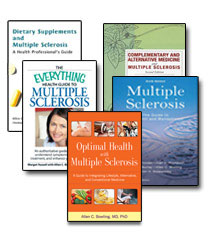CANNABIS INFORMATION SHEET
Copyright 2020 Allen C Bowling, MD, PhD. All Rights Reserved.
DISCLAMER:
Multiple Sclerosis is a serious medical condition. Multiple Sclerosis should not be diagnosed or treated on one’s own. This information is for informational purposes only. This information should not be viewed as a substitute for visiting your health care provider or for using conventional medications. It is highly recommended that you contact your health professional before using any of these therapies.
SUMMARY:
It is not possible to predict how each individual will respond to cannabis products. These products may be harmful and could lead to death.
EFFECTIVENESS:
Many well conducted clinical studies have shown that cannabis products improve MS-associated muscle stiffness (spasticity), pain, and bladder problems. These studies have generally been done with standardized, research-grade preparations that are not available at cannabis dispensaries.
SIDE EFFECTS:
Rigorous studies of the safety of most cannabis products have not been conducted. In limited formal clinical trials of cannabis products, common side effects that have been reported include dizziness, dry mouth, nausea, fatigue, somnolence, euphoria, vomiting, disorientation, drowsiness, confusion, loss of balance, and hallucinations.
Other possible side effects with neurological relevance include impaired cognitive processes (memory, attention, and learning) immediately after use and possibly after discontinuing use. Also, cannabis use has been associated with strokes (due to a condition known as “RCVS”), visual difficulties, and leg weakness.
Other side effects that have been associated with use include addiction, psychosis, depression, suicidality, anxiety, heart attack, lightheadedness with standing (“orthostatic hypotension”), uncontrolled vomiting, liver toxicity, worsened respiratory symptoms (including bronchitis), and testicular cancer. Also, there are unknown side effects due to limited formal safety studies and unknown effects of possible contaminants (see below).
LABORATORY MONITORING:
For products containing cannabidiol (CBD), it is recommended to do blood tests of liver function (LFTs) before starting and then 1, 3, and 6 months after starting. LFTs should then be obtained periodically thereafter or as clinically indicated. LFTs should also be obtained 1 month following increases in CBD dose or the addition of medications with possible liver toxicity.
DRIVING:
Cannabis use doubles the risk of motor vehicle accident. It has been recommended to abstain from use for 8 hours before driving.
SPECIAL POPULATIONS:
There are precautions for specific populations:
- Pregnancy/breastfeeding: Avoid
- Also for women and men: it has been recommended to use reliable contraception while using and abstain for 3 months before trying to conceive.
- Geriatric: limited data, avoid or use with caution
- Pediatric: limited data, multiple additional risks relative to adults
CONDITIONS IN WHICH TO USE CAUTION OR AVOID:
Psychosis, depression, suicidality, anxiety, personal or family history of addiction, stroke, seizures, heart disease, respiratory disease, liver disease, testicular cancer
DRUG INTERACTIONS:
Studies of drug interaction are limited. There are more than 100 possible drug interactions, including steroids and other commonly used neurological medications. Cannabis may add to the sedating effects of alcohol and other psychoactive drugs.
CONTAMINANTS:
Cannabis may be contaminated with metals, microbes (bacteria and fungi), fungal toxins, pesticides, and solvents. Also, smoking and vaping produce multiple toxins. These contaminants and smoking/vaping toxins may have significant adverse health effects.
STORAGE AND STABILITY:
The composition of specific cannabis products may not be known due to unknown stability of cannabis compounds and lack of appropriate storage conditions.
LABELLING:
Labels on products may be incorrect with the amounts of tetrahydrocannabinol (THC) and cannabidiol (CBD). Also, labels may not indicate levels of other cannabis chemicals and other compounds that may have therapeutic or adverse effects.
DISPENSARY STAFF:
Dispensary staff may have no scientific or medical training and may make recommendations that are dangerous or are not based on scientific evidence. Also, staff may recommend products that have incorrect labelling.
REFERENCES:
Prescribing Information: (all accessed on 2/17/20)
Dronabinol (Marinol): www.drugs.com/pro/marinol.html
Nabiximols (Sativex): omr.bayer.ca/omr/online/sativex-pm-en.pdf
Cannabidiol (Epidiolex): www.epidiolex.com/~/EPIDIOLEX_Full_Prescribing_Information.pdf
Books:
Natl Acad of Scis, Engineering, and Medicine. The Health Effects of Cannabis and Cannabinoids: The Current State of Evidence and Recommendations for Research. Washington, DC: The Natl Acad Press;2017:Doi: 10.17226/24625.
Thomas BF and ElSohly M. The Analytical Chemistry of Cannabis. Waltham:Elsevier;2016.
Selected Articles:
Brown JD, et al. Potential adverse drug events and drug-drug interactions with medical and consumer cannabidiol (CBD) use. J Clin Med 2019;8:E989.
Haug NA, et al. Training and practices of cannabis dispensary staff. Cannabis Cannabinoid Res 2016;1:244-251.
Koppel BS, et al. Systematic review: efficacy and safety of medical marijuana in selected neurologic disorders: report of the Guideline Development Subcommittee of the American Academy of Neurology. Neurol 2014;82:1556-1563.
McKernan K, et al. Metagenomic analysis of medicinal Cannabis samples; pathogenic bacteria, toxigenic fungi, and beneficial microbes grow in culture-based yeast and mold tests. F1000Res 2016;5:2471.
Neavyn MJ, et al. Medical marijuana and driving: a review. J Med Toxicol 2014;10:269-79.
Pizzorno J. What should we tell our patients about marijuana (Cannabis indica and Cannabis sativa)? Integr Med 2016;15:8-12.
Rice J, et al. Cannabinoids for treatment of MS symptoms: state of the evidence. Curr Neurol Neurosci Rep 2018;18:50.
Russo EE. Current therapeutic cannabis controversies and clinical trial design issues. Front Pharmacol 2016;7:309.
Vandrey R, et al. Cannabinoid dose and label accuracy in edible medical cannabis products. JAMA 2015;313:2491-2493.
Volkow ND, et al. Adverse health effects of marijuana use. New Eng J Med 2014;370:2219-2227.
Whiting PF, et al. Cannabinoids for medical use: a systematic review and meta-analysis. JAMA 2015;313:2456-2473.
Wolff V, et al. Strokes are possible complications of cannabinoids use. Epil Behav 2017;pii: S1525-5050(16)30735-1. doi: 10.1016/j.yebeh.2017.01.031.
Yadav V, et al. Summary of evidence-based guideline: complementary and alternative medicine in multiple sclerosis: report of the Guideline Development Subcommittee of the American Academy of Neurology. Neurol 2014;82:1-10.
Copyright 2020 Allen C Bowling, MD, PhD. All Rights Reserved.






